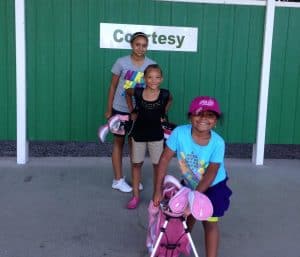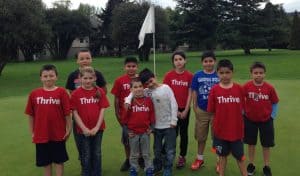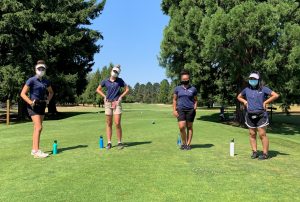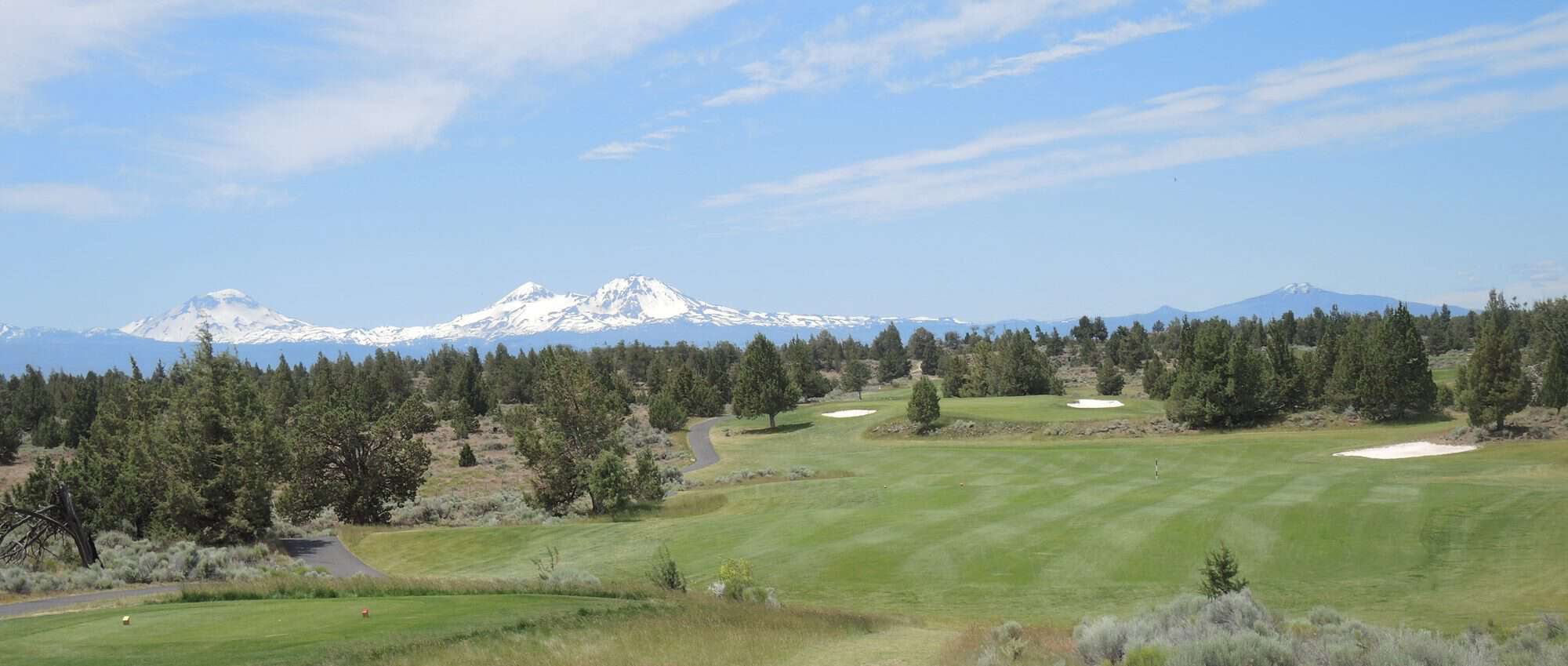[Part II of a two-part series on Improving Diversity on Oregoncourses. The first installment discussed the history of discrimination in golf and in Oregon that has resulted in persons of color being underrepresented on golf courses in Oregon (as well as nationally). This installment looks at some of the programs in Oregon that are trying to improve access to the game for all folks. ]
[NOTE: Details of the programs discussed below are based on pre-COVID; programs may change as we start coming out from under that rock.]
What are the continued barriers in golf preventing an increase in the number of Black golfers in Oregon? There are many, many opinions on what barriers exist. These barriers include lack of access (not only where courses are located but availability of transportation to and from courses), lack of exposure (with some folks citing the loss of caddy programs as a primary problem), too many alternatives with easier access for juniors, lack of equipment, cost (that increases as you get better), and not feeling welcome (which includes a perceived long elitist/imperialist history of the sport and this state [see Part I], overt acts of discrimination, micro and macro aggressions, and simply not knowing what to do when you arrive at a course). There are, of course, probably more.

Are there any programs in Oregon attempting to address any of these barriers? Yes, but there appears to be only a few. The oldest and probably the most comprehensive program was developed by Leisure Hour Golf Club (its founding is discussed in Part I). In 1978, Leisure Hour started the Leisure Hour Junior Golf Program (“LHJGP”) to give all children the opportunity to play golf. The program focuses on juniors between the ages of 6 to college-age. Based out of the Colwood Golf Center, participants are provided with clubs, a golf bag, shoes, balls, snacks, and (very important) transportation to and from learning sessions. After attending four one-hour classroom sessions, participants are provided coaching on the fundamentals of the game over a ten-week period, two hours per week. Mentors are assigned, with about one mentor for ten participants. Education in etiquette, core values, and community service are key aspects of the program. The core values are honesty, integrity, sportsmanship, respect, confidence, responsibility, courtesy, and judgement. Participation is free, but participants are expected to do some sort of community service every year.
As a participant progresses, the lessons become more nuanced, and the participant has the opportunity to play progressively harder courses (e.g., The Children’s Course, then Portland municipal courses), generally with a mentor. The facilities and programing of First Tee (discussed below) are available to the participants. The participants may play the Portland muni courses for free (provided they play with a mentor), and the OGA provides advanced participants with its “Youth on Course” card, providing for play at several courses at a significant discount (like $5 green fees). The number of participants is now capped at 60, and the program is getting more applications than it has positions. The program focuses its recruiting on inner-city communities (and recruits through Home Forward, which provides housing assistance in the Portland Metro area), but is open to juniors of all races. Presently, the diversity makeup of LHJGP participants is about 50 percent Black and 50 percent all other races.
As a participant ages, the LHJGP continues to provide support in lessons and entry into tournaments sponsored by OGA (which will waive entry fees), First Tee, and Western States Golf Association. The LHJGP has also partnered with UNCF in its Signature Preparatory College Program to assist students in applying to college and gaining college scholarships (including Michael Jordan’s UNCF Wings Scholarships).

The program was initially funded by the USGA (which now supports First Tee). Now, funding is through grants, fund raisers (including a big New Year’s Eve party), contributions by First Tee (courses and equipment), Portland Parks (courses), Home Forward (meeting space), and a massive amount of volunteer hours.
The program has some remarkable success stories. Calvin Flax, who went through the program and played in the First Tee Open at Pebble Beach, was the first Black member of the golf team at Jesuit High School, and was a member of the golf team at Lewis & Clark College. Sadena Parks was the first Black golfer on the University of Washington golf team, a multiple winner on the Symetra Tour, and the fifth African American to earn an LPGA Tour card. But probably the most important signs of the success of LHJGP are that the program is at capacity and prior participants in the program have come back to serve as mentors.
It should be noted that LHJGP is not the sole activity of Leisure Hour providing support to junior golfers: the club also provides college scholarships to selected high school golfers.

In 1997, the World Golf Association established The First Tee (now known as First Tee) for new golfers of any race between the ages of 7 and 18. First Tee was created to give juniors access to golf (who may not otherwise have access), and provide a space that makes them feel comfortable and accepted. First Tee is locally present as First Tee-Greater Portland, based at eight courses in the Portland Metro area and Eugene, with its headquarters at The Children’s Course in Gladstone. The program is very similar to that of LHJGP: participants are initially provided with classroom learning in etiquette and core values (the same as LHJGP’s). Participants are then placed in classes of 10 to 20 with 3 to 5 coaches and meet 1 1/2 hours per week for 8 weeks. As a participant’s life and golf skills improve, he or she goes through different levels of participation, culminating at the top, or Ace, level after demonstrating a commitment to give back to the community. Participation is free and participants are provided with equipment and places to play. Funding is primarily through USGA and corporate and individual donations. (The programs provided by LHJGP and First Tee are very similar, and there was an attempt to have LHJGP be a part of First Tee, but the focus by LHJGP on inner-city youth and efforts to make sure that transportation was provided to the course/program site kept the two programs separate.) The program has been very successful. In 2019, First Tee-Greater Portland had over 1,200 participants (including those in LHJGP) with 39 percent of its participants nonwhite.

First Tee-Greater Portland conducts several additional programs. The National School Program provides to elementary schools training, lesson plans, and equipment to get students started in golf. The program targets schools in close proximity to participant courses. In 2019, 33 elementary schools in Eugene and the Portland Metro area participated in this program. First Tee-Greater Portland also conducts the DRIVE Program, working with local nonprofits to expose the game of golf to juniors through clinics, camps, and learning sessions. First Tee–Greater Portland has partnered with over 90 organizations as part of this program. And First Tee-Greater Portland has a unique program, called the THRIVE Mentor program, where it welcomes youth from a local trailer park to teach them core values, helps with homework and school, and provides non-golf community outings.
Two programs focus on caddying to provide part-time employment as well as exposure to golf. The Summit Golf Foundation, created and managed by Quincy Heard (also the golf coach at Alabama State University), conducts the Summit Caddy Program. The program works with IRCO Portland (Immigrant & Refugee Community Organization) to identify up to 24 potential participants between the ages of 16 and 18, and then partners with the Summer Works Program (a collaboration of local governments in the Portland Metro area that targets under-represented youth who face challenges such as growing up in poverty or being at risk of dropping out of high school) to provide the accepted participants part-time summer work as caddies. The program is based at the Glendoveer golf complex, where the participants are provided training and an introduction to golf. Participants then demonstrate their skills to Coach Heard and to the local men’s and women’s clubs before becoming available to the golfing public. If loops are not available, participants help around the course. Participants are provided points for their performances and, if a participant accumulates a sufficient number of points, the participant may be asked to caddy at a local tournament (including a professional tournament). Funding is provided by Summit and the Summer Works Program. The number of participants is presently targeted to be 24, but the program has exceeded the cap in the recent past.

Portland Parks & Recreation, in cooperation with The Western Golf Association Evans Scholarship Program and Portland high schools, manages the EAGLE Caddy Program (Early Adventures in Golf for a Lifetime of Enjoyment). Portland high school freshmen from financially disadvantaged families can apply to the program (participants do not have to be golfers). If accepted, the program provides training, mentors, work-study credit, and part-time employment at a Portland municipal golf course. Students successfully completing this three-year program are eligible to apply for an Evans Scholarship, which provides tuition and housing at University of Oregon (so it’s a pretty big deal). Funding is provided by the Portland municipal golf courses and the Evans Scholarship Program. The program averages ten participants per year, with the vast majority of them being nonwhite.
The programs above may not be the only programs in Oregon that are trying to support Black and nonwhite golfers in Oregon (and if you know of another program please tell me at [email protected]). But the programs by LHJGP, First Tee, Summit, and Portland Parks address many of the barriers preventing an increase in Black golfers in Oregon, and these programs are showing signs of making a difference. But even the success of these programs may not decrease acts of discrimination and macro- micro-aggressions on Oregon courses. It should be noted that Partners In Diversity, an affiliate of the Portland Business Alliance, conducted a three-year study of business professionals of color who recently moved to Oregon or Southwest Washington and found that only 16 percent felt comfortable in public places in Oregon and Southwest Washington. That is not a good thing.
What should Oregon golfers do? Of course, not everyone wants to or has to play golf. But everyone who wants to play should have a chance to learn the game and have the opportunity to enjoy and succeed at the game. For the betterment of the game and all golfing communities, we should all be welcoming, respectful, helpful, and supportive of all golfers at every skill level. We should also support the great programs mentioned above: think about hiring an EAGLE caddy at a Portland municipal course, hiring a Summit caddy at Glendoveer and donating and volunteering for Summit http://www.summitgolf.org/, donating or volunteering at First Tee https://www.firstteegreaterportland.org/donate/ , and donating to (bymailing to LHJGP, 3920 NE Highland, Portland OR 97211) or volunteering with LHJGP (by emailing [email protected]).
I started Part I with a quote, and I’ll end with one as well. In a 2011 Article for USGA, Renee Powell, the first Black to play in the USGA Girls’ Junior Championship and second to play on the LPGA Tour (after Althea Gibson), stated:
“I still hear that many [Black golfers] do not feel welcome in the game and feel uncomfortable on a golf course. Courses, associations, tournaments and other golfers need to realize that in order for the game to remain healthy, we need to grow our sport and welcome everyone who wants to learn and play. We need to send a different message because people will only participate in activities where they feel comfortable. From years of experiencing rejection, people realize very quickly if they are sincerely welcomed. People need to actually see people who look like them to gain a certain level of comfort when beginning a new adventure.”
Prior Articles and Interviews please e-mail [email protected] if you would like to view any of the Prior Articles and Interviews:
Audubon Cooperative Sanctuary Program for Golf Courses in Oregon
Oregon Golf in the Age of COVID-19
The Highest Golf Course In Oregon
Earliest Golf Courses in Central Oregon
Submit your review | |


